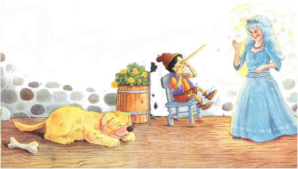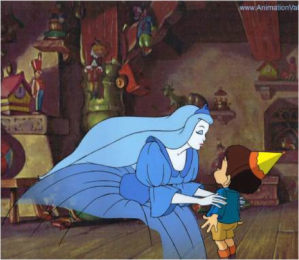Today’s guest entry from Rebekah Fitzsimmons’s “Golden Age of Children’s Literature” class comes to us via Christina Paik. Christina takes us back to Pinocchio, this time looking at the fairy who helps the boy who wants to be a puppet.
By Christina Paik
When Pinocchio attempts to escape from his veiled assassins, he reaches a white cottage that is answered by a girl with “azure hair and a face as white as wax.” Upon seeing the pitiful condition of Pinocchio, this fairy resuscitates the marionette and teaches him an important lesson.
Collodi describes this fairy in different ways throughout the book, but the one characteristic that prevails is her azure hair. She always has an air of beauty, mystery, and patience with her. She also shows signs of being omniscient because she knows all of Pinocchio’s actions without ever physically being with him.
Pinocchio initially disobeys the fairy until it almost costs him his life. At this point, he listens and obeys to the fairy’s wise command to the best of his ability. However, being the young rascal he is, Pinocchio always ends up in trouble for not completely obeying the fairy’s words. She can be thus seen as a maternal figure, although she initially tells him that they will be like siblings.
Interestingly, there are no passages about the fairy’s interactions with any other character than Pinocchio. She states that she has called for Geppetto to live with him, but we never read of her actually talking to Geppetto. Also, the Talking Cricket claims a goat with azure hair gave him the cottage by the sea, but we never see this occurring either. This leads to the idea that maybe the azure fairy is similar to the great grandmother in The Princess and the Goblin because she does not appear openly to everyone. Instead, she gives advice to Pinocchio and watches him from afar.
From the outset, Collodi describes the fairy with endearing terms, making her appear to be a heartwarming, motherly figure who watches over Pinocchio as a mother hen watches her chicks. She shows him patience and forgives him repeatedly, while also making him learn a valuable lesson each time. She could be closely tied to a religious aspect because she teaches him about important morals in life that Pinocchio must learn to become a “real” boy. When he finally obeys her commands and lives up to his responsibilities at the end of the book, she grants him riches, his father youth, and magically changes him into a real boy. This is similar to the idea that following the Christian path will make one happy, spiritually rich, and ultimately give them an afterlife.
Thus, this fairy with azure hair is necessary to help Pinocchio grow into a mature boy. With her direction, Pinocchio changes himself from a reckless, rash boy into a responsible boy who can provide for his family. Although Pinocchio has Geppetto as a father, it is the fairy who teaches Pinocchio all of the important life lessons. When he shows his selfless attitude in the final chapter of Pinocchio by giving his fifty pennies to the snail for saving the fairy’s life, she grants him the greatest gift of being a real human boy.
Christina is an undergraduate at the University of Florida.



